GB∕T 7321-2017 定形耐火制品试样制备方法/Method for preparing samples of shaped refractory products
定形耐火制品试样制备方法
1范围
本标准规定了定形耐火制品制样的定义、制样部位的确定原则和试样的制备。
本标准适用于定形耐火制品试样的制备。
2规范性引用文件
下列文件对于本文件的应用是必不可少的。凡是注日期的引用文件,仅注日期的版本适用于本文件。凡是不注日期的引用文件,其最新版本(包括所有的修改单)适用于本文件。
GB/T18930耐火材料术语
3术语和定义
GB/T 18930界定的以及下列术语和定义适用于本文件,
3.1
制样sample preparation
从样本制取试样的过程。
3.2
试样 test sample
从样本中制备的用于测试的样品。
4制样部位的确定原则
4.1应在样本质量的薄弱部位或使用的关键部位制取试样。
4.2试样的制取部位应能反映出被检测样本的性能,且具有较好的代表性。
4.3对于形状复杂的大型样本或难以制成试验方法标准要求尺寸试样的特殊样本,应由有关方协商确定或按有关规定制取试样。
4.4试样的制取部位应避开样本外观有裂纹、熔洞等缺陷的部位。
5试样的制备
5.1标型、普型耐火制品
5.1.1致密定形耐火制品的显气孔率,体积密度、耐压强度、加热永久线变化、荷重软化温度及压蟠变用试样通常在样本的角上制取(切取或钻取)。如果样本较小,同一块样本上不能满足制取所有项目要求时,可在不同的样本上制取,但要满足以下条件:
a)常温项目如显气孔率与常温耐压强度试验用试样应在同一个样本上制取;
b)高温项目如荷重软化温度、压蠕变与加热永久线变化试验用试样应在同一样本上制取。
致密定形耐火制品显气孔率等试样的制取部位的示例如图1所示,
5.1.2定形隔热耐火制品的体积密度、耐压强度、加热永久线变化试样在样本的端部切取,对于标普型样本,体积密度、抗热震性试样可采用整砖。导热系数试样按试验方法标准的要求制取。
5.1.3常温抗折强度和高温抗折强度试样,通常在样本成型时的加压面上切取,并尽可能保留样本成型时加压方向的原砖面作为试验时的压力面。
5.1.4耐磨性试样,通常在砖的工作端切取,且保留原砖面作为试验面。
5.1.5导热系数(激光法)、热膨胀等试样的制取部位可按第4章,在距样本边缘15 mm以上的合适位置制取。
5.1.6抗渣性及抗铁水熔蚀性试样,在工作端钻取,对回转抗渣性试样根据试验方法标准要求制备。
5.1.7抗碱性试样的制样原则:
a)碱蒸气法和熔碱坩埚法:按试验方法的要求部位制样,尽可能多的保留原砖面;
b)熔碱埋覆法:在表面和芯部各3条。
5.1.8抗一氧化碳破坏性试样:在样本的合适部位制取,至少保留3个原砖面。
5.1.9抗热震性试样的制样原则:
a)水急冷法-直形砖试样:标准砖,直接试验,当样本较大时,端部切取,试样加热面应是原砖面;
b)水急冷法-小试样:合适部位钻取;
c)空气急冷法:工作端制取,长度沿样本的工作面,若工作面长度不足114mm,可以沿样本的长度方向,样本的工作面为试样的喷吹面和张力面,做好标记。
5.1.10杨氏模量试样在样本合适部位制取。
5.1.11化学分析、耐火度、真密度、耐硫酸侵蚀等粉状或颗粒状试样,在每个样本上制取有代表性的样品,破碎、缩分、研磨至规定粒度。可使用耐压强度测试后的试样。如果样本表面有污染,需进行处理。对表皮和内层明显不一致的样本,在制取化学分析试样时应充分考虑试样的代表性。
5.1.12对于由两种或多种材质组成的复合材料,可按技术标准要求、相关合同文件、图纸要求或有关方协商确定在合适部位制样。
5.1.13如有特殊要求,在符合第4章原则下,制样部位可由有关方协商决定,并应在试验报告中说明。
5.1.14对需要保留样本的情况,除需整块进行试验的样本外,一般每块样本一切两半,半块作为制样用,另半块作为保留样本。
5.2异型、特异型耐火制品
a)碱蒸气法和熔碱坩埚法:按试验方法的要求部位制样,尽可能多的保留原砖面;
b)熔碱埋覆法:在表面和芯部各3条。
5.1.8抗一氧化碳破坏性试样:在样本的合适部位制取,至少保留3个原砖面。
5.1.9抗热震性试样的制样原则:
a)水急冷法-直形砖试样:标准砖,直接试验,当样本较大时,端部切取,试样加热面应是原砖面;
b)水急冷法-小试样:合适部位钻取;
c)空气急冷法:工作端制取,长度沿样本的工作面,若工作面长度不足114mm,可以沿样本的长度方向,样本的工作面为试样的喷吹面和张力面,做好标记。
5.1.10杨氏模量试样在样本合适部位制取。
5.1.11化学分析、耐火度、真密度、耐硫酸侵蚀等粉状或颗粒状试样,在每个样本上制取有代表性的样品,破碎、缩分、研磨至规定粒度。可使用耐压强度测试后的试样。如果样本表面有污染,需进行处理。对表皮和内层明显不一致的样本,在制取化学分析试样时应充分考虑试样的代表性。
5.1.12对于由两种或多种材质组成的复合材料,可按技术标准要求、相关合同文件、图纸要求或有关方协商确定在合适部位制样。
5.1.13如有特殊要求,在符合第4章原则下,制样部位可由有关方协商决定,并应在试验报告中说明。
5.1.14对需要保留样本的情况,除需整块进行试验的样本外,一般每块样本一切两半,半块作为制样用,另半块作为保留样本,
5.2异型、特异型耐火制品
5.2.1能按标、普型耐火制品制样的异型、特异型耐火制品,尽量按照第4章及 5.1 的规定制样。
5.2.2对不能按规定制取试样的异型、特异型耐火制品,显气孔率、体积密度和加热永久线变化试样的制样:致密定形耐火制品制取的试样应尽量保留表皮,体积应为50cm’~200cm’,试样的最长尺寸
a)与最短尺寸之比不超过2:1;
b)定形隔热耐火制品在端部切取;
c)对制品上下两端大小不同或上下两端不对称的,应从工作端或小端制取,对长形制品,应在中间部位制取。
5.2.3铸钢用砖、连铸用砖、透气砖等耐火制品的制样原则:
a)连铸用耐火制品:化学成分、体积密度、显气孔率、常温耐压强度、常温抗折强度试样对照图纸从相应部位制取,塞棒在塞头端制取。抗热震性试样,可用整支制品或从制品上切取一段,长水口在大口端制取;浸人式水口在钢水流出端制取;整体塞棒在塞头端制取;
b)透气砖:在大头截去 20 mm~30 mm 厚的中心部位钻取,也可以采用同一工艺制成的试样;
c)滑板砖:显气孔率、体积密度试样在砖的宽度方向铸口边缘部位;耐压强度试样在砖的长度方向接触钢水区域内制样;
d)对于复合材料,可按技术标准要求、相关合同文件、图纸要求或有关方协商确定在合适部位制样。
异型、特异型耐火制品显气孔率等试样的制取部位的示例如图2~图9所示。
5.2.4对于难以按以上规则要求制样的样本,可按双方要求协商制样。

说明:
1–荷重软化温度、压蟠变试样;
2–加热永久线变化试样;
3–常温耐压强度试样;
4–显气孔率试样。
图1致密定形耐火制品 标型、普型砖 制样部位示意图
图2圆筒型砖 制样部位示意图
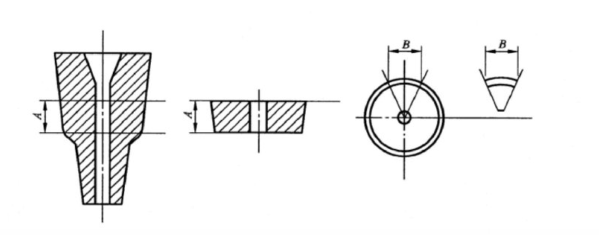
图3铸口砖 制样部位示意图

图4流钢砖制样部位示意图
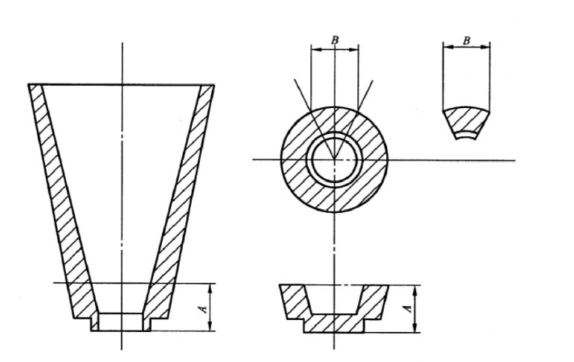
图5漏斗砖制样部位示意图
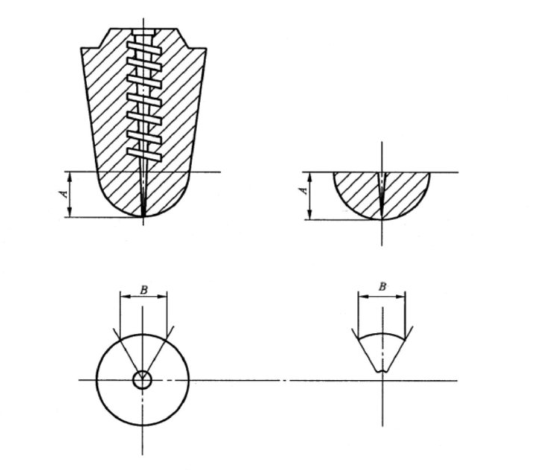
图6塞头砖制样部位示意图
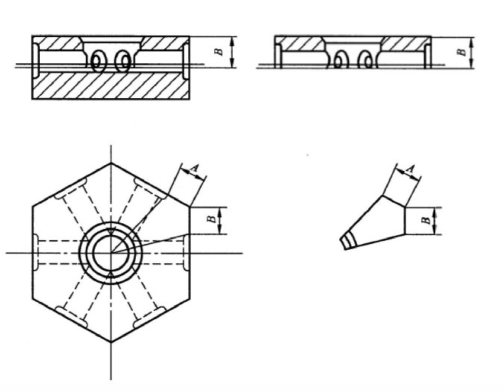
图7中心砖 制样部位示意图
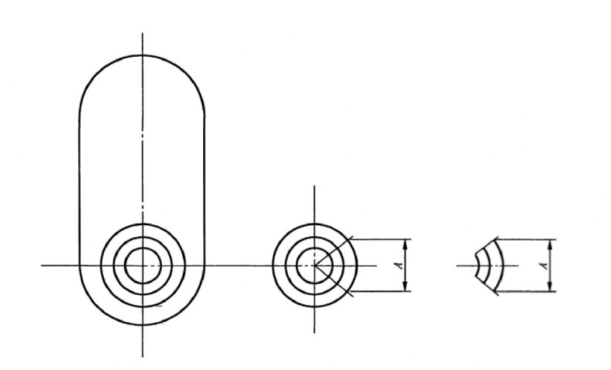
图8滑板砖 制样部位示意图

图9整体塞棒砖 制样部位示意图
Method for preparing samples of shaped refractory products
1 Range
This standard specifies the definition of sample preparation of shaped refractory products, the principle of determining the sample preparation site and the preparation of samples.
This standard is applicable to the preparation of shaped refractory products.
2 Normative reference documents
The following documents are essential for the application of this document. For dated references, the date-only version applies to this document. For undated references, the latest version (including all amendment orders) applies to this document.
GB/T18930 Refractory terminology
3 Terms and definitions
As defined in GB/T 18930 and the following terms and definitions apply to this document,
3.1
Sample preparation
The process of making a sample from a sample.
3.2
Test sample
A sample prepared from a sample for testing.
4.Determination principle of sample preparation site
4.1 Samples should be made in the weak part of sample quality or in the key part of use.
4.2 The preparation part of the sample should be able to reflect the performance of the sample to be tested and have a good representation.
4.3 For large samples with complex shapes or special samples that are difficult to make the sample size required by the test method standard, the sample shall be determined by the parties concerned through consultation or prepared in accordance with the relevant provisions.
4.4 The preparation part of the sample should avoid the parts with cracks, melting holes and other defects on the appearance of the sample.
5 Preparation of samples
5.1 Standard and general refractory products
5.1.1 The apparent porosity, bulk density, compressive strength, heating permanent line change, load softening temperature and pressure coil change of dense shaped refractory products are usually prepared at the corner of the sample (cut or drilled). If the sample is small, the same sample can not meet all the requirements for making all items, can be made on different samples, but to meet the following conditions:
a) Samples for normal temperature items such as apparent porosity and normal temperature compressive strength test shall be prepared on the same sample;
b) Samples for high temperature items such as load softening temperature, pressure creep and heating permanent line change tests should be prepared on the same sample.
An example of the preparation location of samples such as apparent porosity of dense shaped refractory products is shown in Figure 1.
5.1.2 The sample of volumetric density, compressive strength and heating permanent line change of shaped thermal insulation refractory products is cut at the end of the sample. For S&P type samples, the sample of volumetric density and thermal shock resistance can be made of whole brick. The thermal conductivity sample shall be prepared according to the requirements of the test method standard.
5.1.3 Samples with normal temperature and high temperature flexural strength are usually cut on the pressure surface of the sample when it is formed, and the original brick surface in the pressure direction of the sample when it is formed is retained as much as possible as the pressure surface of the test.
5.1.4 The wear resistance sample is usually cut at the working end of the brick, and the original brick surface is retained as the test surface.
5.1.5 Thermal conductivity (laser method), thermal expansion and other samples can be prepared at a suitable position 15 mm above the edge of the sample according to Chapter 4.
5.1.6 The slag resistance and molten iron corrosion resistance samples shall be drilled at the working end, and the rotary slag resistance samples shall be prepared according to the standard requirements of the test method.
5.1.7 Principles for preparation of alkaline resistant samples:
a)alkali vapor method and molten alkali crucible method: Prepare samples according to the required parts of the test method, and retain the original brick surface as much as possible;
b)Molten alkali embedding method: 3 pieces each on the surface and core.
5.1.8 Anti-carbon monoxide destructive sample: in the appropriate part of the sample, at least 3 original brick surfaces are retained.
5.1.9 Sample preparation principles for thermal shock resistance samples:
a) Water quenching method – Straight brick sample: standard brick, direct test, when the sample is large, cut the end, the sample heating surface should be the original brick surface;
b) Water quenching method – small sample: drill the appropriate part;
c) Air quenching method: the working end is prepared, and the length is along the working face of the sample. If the working face length is less than 114mm, it can be along the length direction of the sample. The working face of the sample is the blowing face and tension surface of the sample, and it is well marked.
5.1.10 Young’s modulus samples are prepared at appropriate parts of the sample.
5.1.11 Chemical analysis, fire resistance, true density, sulfuric acid corrosion resistance and other powder or granular samples, on each sample to prepare a representative sample, broken, divided, ground to the specified particle size. Specimens can be used after compressive strength testing. If the surface of the sample is contaminated, it needs to be treated. For the samples whose epidermis and inner layer are obviously inconsistent, the representativeness of the samples should be fully considered when preparing the samples for chemical analysis.
5.1.12 For composite materials composed of two or more materials, samples can be prepared at appropriate locations according to the requirements of technical standards, relevant contract documents, drawings or the parties concerned through negotiation.
5.1.13 If there are special requirements, subject to the principles of Chapter 4, the sample preparation site may be decided by the parties concerned through consultation and shall be described in the test report.
5.1.14 In cases where samples need to be retained, each sample is generally divided in half, with one half used for sample preparation and the other half used as retained sample, except for samples that need to be tested as a whole.
5.2 Special type and special type refractory products
a) alkali vapor method and molten alkali crucible method: Prepare samples according to the required parts of the test method, and retain the original brick surface as much as possible;
b) Molten alkali embedding method: 3 pieces each on the surface and core.
5.1.8 Anti-carbon monoxide destructive sample: in the appropriate part of the sample, at least 3 original brick surfaces are retained.
5.1.9 Sample preparation principles for thermal shock resistance samples:
a) Water quenching method – Straight brick sample: standard brick, direct test, when the sample is large, cut the end, the sample heating surface should be the original brick surface;
b) Water quenching method – small sample: drill the appropriate part;
c) Air quenching method: the working end is prepared, and the length is along the working face of the sample. If the working face length is less than 114mm, it can be along the length direction of the sample. The working face of the sample is the blowing face and tension surface of the sample, and it is well marked.
5.1.10 Young’s modulus samples are prepared at appropriate parts of the sample.
5.1.11 Chemical analysis, fire resistance, true density, sulfuric acid corrosion resistance and other powder or granular samples, on each sample to prepare a representative sample, broken, divided, ground to the specified particle size. Specimens can be used after compressive strength testing. If the surface of the sample is contaminated, it needs to be treated. For the samples whose epidermis and inner layer are obviously inconsistent, the representativeness of the samples should be fully considered when preparing the samples for chemical analysis.
5.1.12 For composite materials composed of two or more materials, samples can be prepared at appropriate locations according to the requirements of technical standards, relevant contract documents, drawings or the parties concerned through negotiation.
5.1.13 If there are special requirements, subject to the principles of Chapter 4, the sample preparation site may be decided by the parties concerned through consultation and shall be described in the test report.
5.1.14 In cases where samples need to be retained, except for samples that need to be tested as a whole, each sample is generally divided into two parts, one part is used for sample preparation, and the other half is used as a reserved sample.
5.2 Special type and special type refractory products
5.2.1 For special-shaped and special-shaped refractory products that can be prepared according to standard and general refractory products, samples shall be prepared in accordance with the provisions of Chapter 4 and 5.1 as far as possible.
5.2.2 For special-shaped and special-shaped refractory products that cannot be prepared as required, sample preparation of samples with apparent porosity, bulk density and heating permanent line changes: Samples made from dense shaped refractory products should retain the skin as far as possible, and the volume should be 50cm’~200cm’, the longest size of the sample
a) The ratio to the shortest dimension shall not exceed 2:1;
b) Shaped heat-insulating refractory products are cut at the end;
c) The upper and lower ends of the product are different in size or the upper and lower ends are asymmetrical, should be made from the working end or small end, for long products, should be made in the middle part.
5.2.3 Sample preparation principles of refractory products such as cast steel bricks, continuous casting bricks and breathable bricks:
a) Refractory products for continuous casting: chemical composition, bulk density, apparent porosity, compressive strength at room temperature, bending strength at room temperature samples are prepared from the corresponding parts according to the drawing, and the plug rod is prepared at the end of the plug head. The thermal shock resistance sample can be used as a whole product or a section cut from the product, and the long water nozzle is prepared at the large mouth end; The submerged nozzle is prepared at the molten steel outflow end; The whole plug is made at the end of the plug head;
b) Breathable brick: the central part of the big head cut 20 mm~30 mm thick is drilled, and the sample made of the same process can also be used;
c) Skateboard brick: the apparent porosity and bulk density samples are at the edge of the cast in the width direction of the brick; The compressive strength sample is prepared in the area where the length of the brick touches the molten steel.
d) For composite materials, samples can be prepared at appropriate locations according to the requirements of technical standards, relevant contract documents, drawings or negotiations between the parties concerned.
Examples of sampling locations for samples such as apparent porosity of special-shaped and special-shaped refractory products are shown in FIG. 2-9.
5.2.4 For samples that are difficult to prepare according to the requirements of the above rules, samples can be prepared through negotiation according to the requirements of both parties.

Instructions:
1– samples with softening temperature and pressure variation under load;
2– heating the sample with permanent linear change;
3– normal temperature compressive strength sample;
4– apparent porosity sample.
FIG. 1 Schematic diagram of sample parts of standard and general shaped brick for compact shaped refractory products

FIG. 2 Schematic diagram of the sampling position of cylindrical brick
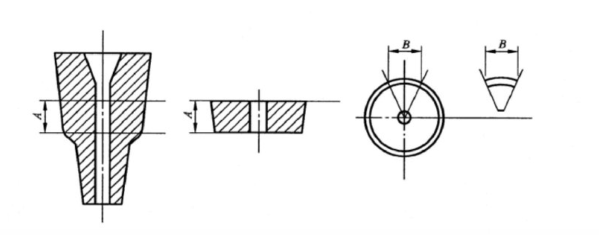
FIG. 3 Schematic diagram of sample making position of cast brick

FIG. 4 Schematic diagram of sample making position of flow steel brick
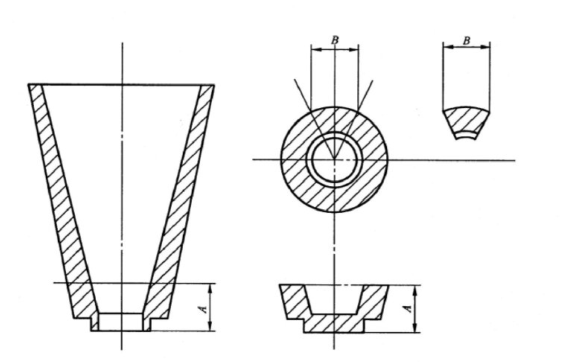
FIG. 5 Schematic diagram of funnel brick sampling position
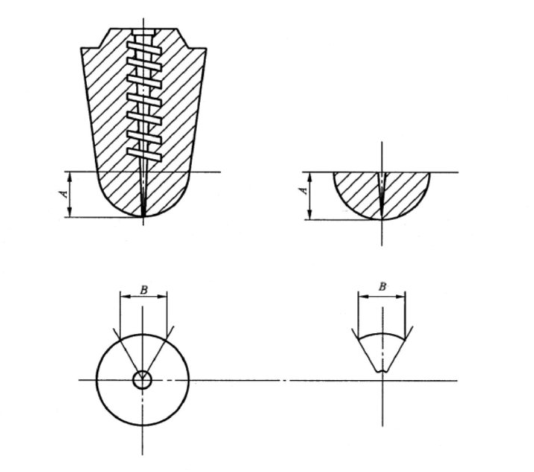
FIG. 6 Schematic diagram of sample making position of plug head brick
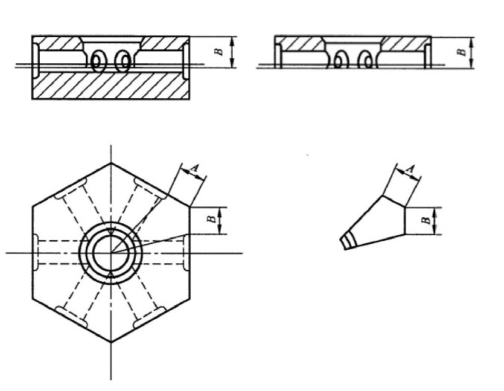
FIG. 7 Schematic diagram of the central brick sampling position

FIG. 8 Schematic diagram of sample making part of skateboard brick
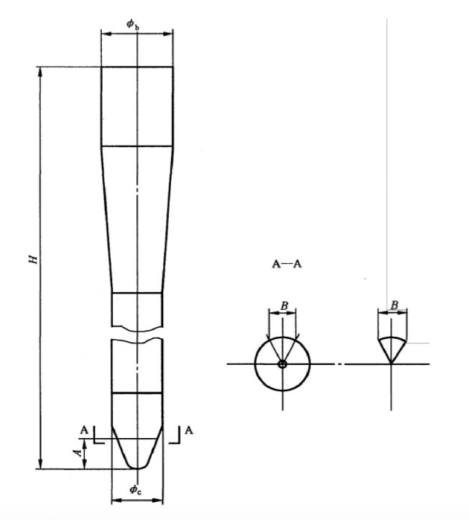
FIG. 9 Schematic diagram of sample parts of the whole stopper brick



